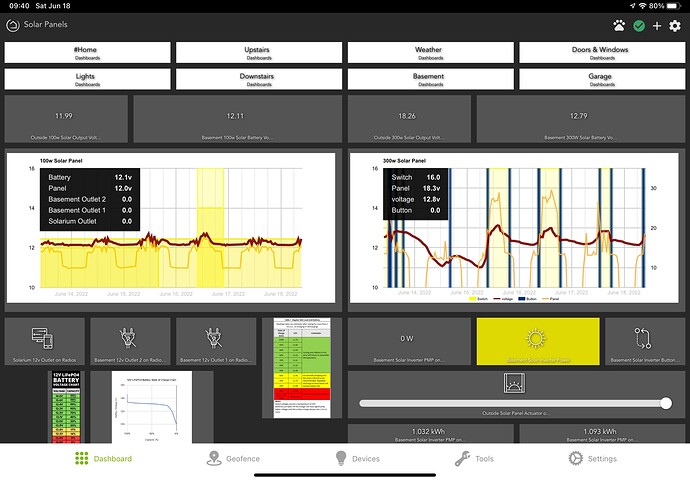We're looking into getting solar this year. Anything we should be looking for specifically to integrate with Hubitat?
Iotawatt
I'm not using solar but iotawatt does integrate with solar and HE integration.
Have one of those and love it. Wasn't sure if there were other things I should be looking for like a solar interface that outputs graph data that I can incorporate or what have you (In my brain I do not have a plan fleshed out for anything yet)
I have a couple of solar panels, one that I have my work laptop and a few other devices plugged into - this one automatically switches between grid and battery depending on voltage. The other I use to charge our mobile devices and some spare batteries for when we have multiple rainy days in a row.
I setup a dashboard using Hubigraph and really like it. This is all just for testing and education for now, until I finally decide to move to whole home solar…
It’s still early, so there is not enough juice in the batteries yet, so everything is off for now.
The graph shows the voltage coming in from the panels and what is read on the batteries. The picture on the bottom / left are for reference only - show what voltage equates to what fill level. I use a 100 ah LiFePO4 battery on my 300w panel, and 2 x 50 ah AGM batteries on my 100w panel.
Hi @rlithgow1 and @Sebastien
I'm getting a solar installation at my home later this summer. I will be getting enphase inverters (plus the enphase monitoring app). I am using Sense to monitor power use in the home. Would be great to integrate either Enphase or Sense into Hubitat.
My details
My goal is to find some automation to reduce peak demand from our utility (kW avg over each 30 min interval) during peak-rate hours. (Battery backup is not economical, IMO, and I don't wish to install a physical demand limiter.) Peak demand is a greater factor in our power bill than total energy used. Peak demand is the maximum demand for any 30-min (peak) period for the entire billing cycle.
To support this goal, I've installed Hubitat Elevation and two Ecobee thermostats (V4). The Ecobees responds well to temperature commands from the Hubitat. (I plan to install a custom integration soon to learn what else I can do.)
So, here in Phoenix (Hades) I want to use our heat pump(s) when the solar panels generate enough power. But on those days with afternoon clouds (yes, it happens), I need to stop using the heat pumps when there is insufficient solar production.
So, as you see, I'm less interested in monitoring/dashboard implementation than in automating our peak demand.
Sorry for the long post. I'm enjoying HE and hope to implement an automation to control my energy use/costs. Thank you!
Are your heat pumps connected to Hubitat? If so, you could probably use an outside LUX monitor to figure out the solar output, and turn them off when LUX level goes below a threshold for a specific period of time…
@ Sebastian, Thank you.
Yes, and I was thinking along those lines. Perhaps that's the most practical approach. But I'd need to calibrate the lux meter to solar output. The heat pumps are controlled by Ecobee Thermostats, which are connected to HE.
I'll start looking for lux meters that can respond with our (very bright and hot) sunshine.
Thank you again! 
I think that Hue’s external motion sensor has a LUX sensor. Not sure if it would meet your needs though.
@Sebastian,
Thank you once again! Yes, the Philips Hue Outdoor sensor includes a light meter. I have not found specifications from Philips, but on the web there are mentions of upper limit of around 130,000 lux. It probably gets a little brighter than that here, but I think it will be ok for my purposes.
The operating temperature range goes up to 45 C. We have air temperatures that exceed that number sometimes. Of course, with solar radiation objects tend to get hot.
I think I'll give it a try. There is probably a work-around to be found if necessary.
Thank you so much for your help! 
Just a heads up, I do have one of the Hue outdoor motions and I checked to see if it had ever reported anything in the luminance range you need only to find it hadn't reported any luminance in the existing event history. I don't use that sensor for luminance so never noticed the lack of data. I also have the indoor motion and use it for luminance and it has been working fine. Could be an oddity on this particular sensor but wanted to give a heads up of a potential problem down the road. I'm away for a bit but will investigate for my on uses later.
One of the things you may want to consider to measure lux is a tempest weather station. Integrates well with hubitat and is the best lux meter in my setup.
I likewise use the Weather flow Tempest. It's also my best luminance sensor in the mix but it's a bit of an overkill for just a luminance sensor.
Thank you for the heads up. I've been checking comments from other HE users, and they report lux readings from the sensor (maybe every 5 min or so).
I plan to give it a try. The motion sensors will be useful anyway if I'm unsuccessful.
Thanks!
Appreciate the suggestion for Weather Flow Tempest. Looks cool. Yes, a bit pricey for me, but I'll consider it after I evaluate the Hue motion sensors.


It's probably a bad pairing on my end.
Looks like they are partial to a weatherflow tempest setup.... Which can integrate with various Community drivers.... including EcoWitt.... which I have recently become aware of....




